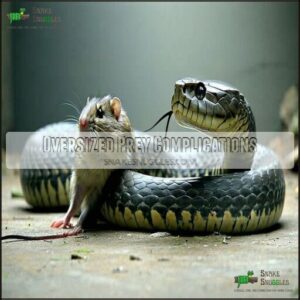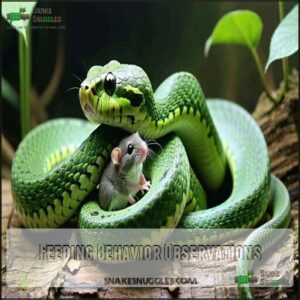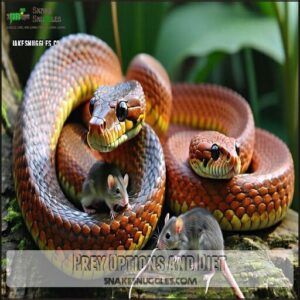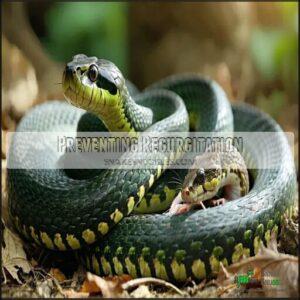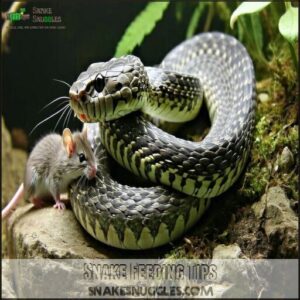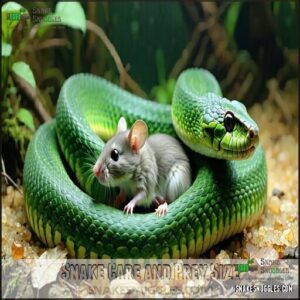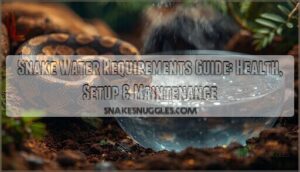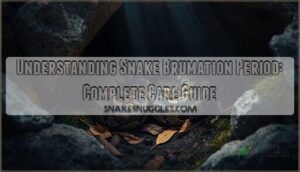This site is supported by our readers. We may earn a commission, at no cost to you, if you purchase through links.
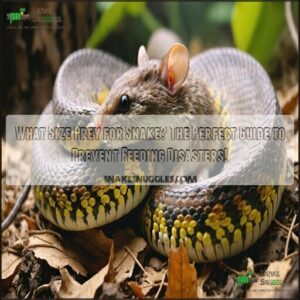
If the prey’s noticeably smaller, your snake might still feel hungry, like eating one potato chip when you need a meal. If it’s too big, you risk stress, regurgitation, or even choking.
Hatchlings usually start with pinkie mice, while larger snakes can handle adult rats. Always consider your snake’s species, age, and growth stage.
Keep an eye on feeding habits—refusal or regurgitation may mean a size adjustment’s needed. Curious about other feeding tips? There’s more to learn for your snake’s health!
Table Of Contents
- Key Takeaways
- Choosing Snake Prey Size
- What Size Prey for Snakes
- Prey Size and Health Risks
- Feeding Behavior Observations
- Prey Options and Diet
- Prey Size Adjustments
- Preventing Regurgitation
- Snake Prey Selection
- Snake Feeding Tips
- Snake Care and Prey Size
- Frequently Asked Questions (FAQs)
- What size prey should I feed my snake?
- How large of prey can snakes eat?
- How to tell if prey is too big for a snake?
- What determines what prey a snake will eat?
- How to store frozen prey for snakes?
- Can snakes eat wild-caught prey safely?
- What to do if snake refuses food?
- Are there alternative food options for snakes?
- When is it safe to handle after feeding?
- Conclusion
Key Takeaways
- Match the prey’s diameter to your snake’s widest body part, aiming for about 10% of its body weight without exceeding 1.5 times its width.
- Feeding prey that’s too large can cause choking, regurgitation, or injuries, while prey that’s too small won’t give enough nutrition.
- Adjust prey size as your snake grows, ensuring it supports healthy digestion and development at every stage.
- Avoid handling your snake 24-48 hours after feeding to prevent stress and regurgitation.
Choosing Snake Prey Size
You’ll need to select prey that’s approximately the same diameter as your snake’s widest point, generally around 10% of its body weight, to guarantee proper digestion and prevent health complications.
Choosing prey that’s too large can cause regurgitation or injury, while prey that’s too small won’t provide adequate nutrition for your growing reptile, which can lead to health complications.
Measuring Snake Width
Finding the right snake prey size starts with accurate width measurements. Proper measuring techniques guarantee your serpent gets appropriate prey size for healthy digestion.
Here’s how to measure your snake’s width:
- Use the String Method – wrap a piece of string around the snake’s widest point
- Try Caliper Use for precise measurements
- Rely on Visual Estimation with a ruler for quick checks
- Consider Growth Stages and Body Condition when measuring
For enhanced accuracy, consider using specialized measuring tools.
Prey Size Guidelines
The golden rule of prey diameter sits at the core of successful snake feeding.
Your snake’s prey should match the width of its thickest body section and constitute approximately 10% of its body weight.
Never exceed 1.5 times the snake’s maximum size at its widest point.
Consistent size guarantees easy swallowing and prevents digestive disasters.
This appropriate prey size guide keeps your snake healthy while allowing proper nutrition absorption from rodent meals.
Factors Affecting Prey Size
Several factors beyond simple width measurements affect the prey size your snake needs.
Snake age, species differences, and overall health condition directly impact appetite and digestive capacity. Environmental temperature influences metabolism, while activity level determines caloric requirements.
A growing juvenile needs proportionally larger meals than an adult of similar size.
Remember that snake weight (not just length) helps determine appropriate rodent size for safe, efficient feeding.
What Size Prey for Snakes
A reliable snake prey size guide follows one simple principle: match the prey’s width to your snake’s thickest body section.
This key ratio prevents feeding disasters while ensuring proper nutrition.
Whether you’re offering frozen vs live prey, maintaining the proper prey circumference is essential.
Here’s what you need to know about determining correct prey size:
- Use the 10% rule: prey should weigh approximately 10% of your snake’s body weight
- Compare prey diameter to the widest part of your snake’s body (they should be roughly equal)
- Never exceed 1.5 times your snake’s width at its thickest point
- Consider prey weight ratio when selecting between multiple prey items
- Understand that wild snake diets naturally follow similar sizing patterns
Alternative prey options follow these same guidelines.
Snakes use varied methods, including constriction for suffocation, to subdue their prey.
Remember, "one mouse-sized meal beats two pinkie-sized problems" as experienced keepers say.
Snake feeding guidelines emphasize quality over quantity when selecting rodent size for your slithering friend.
Prey Size and Health Risks
You’ll risk serious health complications for your snake if you don’t match prey size correctly to your snake’s body width, as oversized items can cause regurgitation and digestive blockages while undersized prey leads to nutritional deficiencies.
Proper sizing—approximately equal to the snake’s widest body point but never exceeding 1.5 times this width—ensures ideal digestion and prevents the digestive disasters that many new snake owners unfortunately learn about the hard way, which can be attributed to digestive blockages.
Undersized Prey Issues
While selecting the right prey size is essential for your snake’s health, feeding items that are too small can lead to serious issues.
Undersized prey can cause nutritional deficiencies, slowed growth, and weight loss in your snake.
You’ll also notice increased hunger, as your pet simply isn’t getting enough calories to thrive, which often results in frequent feeding requests.
Your snake may seem constantly hungry despite regular meals, highlighting the importance of proper prey size for its overall health and well-being.
Oversized Prey Complications
After feeding your snake oversized prey, you’re inviting serious health complications.
Oversized prey invites trouble for snakes, risking regurgitation, gut impaction, and serious health complications you can easily avoid with proper sizing.
When prey exceeds 1.5 times your snake’s widest body point, you risk injury risks including throat tears and gut impaction.
Oversized meals often cause regurgitation, placing tremendous stress on your snake’s digestive system.
This feeding obstacle isn’t just uncomfortable—it can be life-threatening.
Remember, your snake can’t chew smaller pieces like we can; they’re designed to consume appropriately-sized prey whole.
Risks can include digestive system damage, which is a significant concern for snake owners.
Digestive Problems
When prey is improperly sized, your snake’s digestive system faces significant challenges. Those oversized mice or rats can cause digestive stress beyond simple discomfort. Your snake’s body isn’t designed to process meals that exceed its capacity.
- Impaction risks increase when prey exceeds 1.5 times the snake’s width
- Regurgitation causes include overstretched stomach muscles and excessive digestive effort
- Digestive enzymes can’t effectively break down disproportionately large meals
- Gut health deteriorates with repeated digestive issues, potentially leading to long-term complications
Feeding Behavior Observations
You’ll notice specific behaviors when your snake encounters appropriately sized prey, including efficient constriction and smooth swallowing without straining.
Watching for these feeding cues can help you identify when prey is too large, as struggling to manipulate food, excessive jaw stretching, or regurgitation within 48 hours are clear signs your snake’s meal exceeded ideal size, indicating a need to adjust the prey size.
Snake Feeding Habits
Understanding how snakes feed can protect their health after you’ve chosen the right prey size.
You’ll notice snakes typically swallow their prey whole and headfirst, using constriction to immobilize it first.
Their hunting instincts remain strong in captivity, which is why some snakes prefer live prey over frozen options.
Most captive snakes adjust their feeding frequency based on meal size, naturally stopping when they’re full, which relates to their overall health.
Regurgitation Signs
When your snake regurgitates its meal, you’ll notice distinct warning signs that shouldn’t be ignored.
Watch for a distended abdomen, visible discomfort signs, and food rejection within 48 hours of feeding. Swallowing difficulty during feeding often indicates prey size is too large.
Remember, regurgitation differs from vomiting—regurgitation expels undigested food, while vomiting contains partially digested matter.
Repeated incidents require immediate veterinary attention to prevent serious health complications.
Stress and Feeding
A tranquil snake is a happy eater.
Avoid handling your snake 48 hours before and 24 hours after feeding to minimize stress.
Environmental stressors like noise, bright lights, or enclosure disturbances can trigger regurgitation.
Your feeding schedule should accommodate your snake’s natural rhythm—never force meals when they’re shedding or already stressed.
Remember, proper prey size combined with a calm environment creates the perfect dining experience for your scaly friend.
Prey Options and Diet
You’ll need to offer your snake the right prey options based on its size, species, and developmental stage for healthy and growth.
From pinkie mice for hatchlings to appropriately sized rats for adults, selecting prey that’s approximately the same diameter as your snake’s widest point guarantees proper nutrition without risking digestive complications.
Rodent Prey
The trusty rodent menu forms the backbone of most captive snake diets. You’ll find various options ranging from pinkie mice (15g-25g) to weaned rats (250g+).
Maintain size consistency by selecting prey that’s approximately 10% of your snake’s body weight. Frozen rodents are generally safer than live ones, reducing injury risks.
Many reptile owners purchase quality frozen feeders for their snakes. Quality matters—source farm-raised rodents with proper nutrition to guarantee your snake receives the best rodent nutrition for healthy growth.
Insect Prey
While rodents make up the bulk of most snake diets, certain species rely heavily on insect prey. For smaller or specialized snakes like garter snakes and green snakes, insects offer perfect nutritional packages when sized appropriately.
Some snakes, like flowerpot snakes, have a specialized termite diet.
When offering insect prey, follow these guidelines:
- Choose insects approximately equal to your snake’s widest body width
- Gut-load insects with calcium-rich foods 24 hours before feeding
- Offer variety through crickets, dubia roaches, and appropriate worms
- Feed small insect-eating snakes every 2-3 days
- Never leave live insects unattended with your snake
Amphibian Prey
While insects serve smaller species, amphibians provide excellent nutritional variety for many snakes.
Garter snakes particularly rely on frogs and toads as primary food sources. The prey’s width, not length, remains essential for safe feeding.
| Snake Species | Amphibian Preference | Size Considerations |
|---|---|---|
| Garter Snake | Frogs, small toads | Match body width |
| Puff Adder | Uses lingual luring | Avoid oversized prey |
| Water Snake | Aquatic amphibians | Monitor digestion |
Remember: some snakes avoid salamanders/toads due to toxic skin secretions.
Prey Size Adjustments
You’ll need to adjust your snake’s prey size as it grows, ideally maintaining items that match the widest part of its body and constitute about 10% of its weight.
Consistent monitoring of your snake’s feeding response, body condition, and growth rate will help you determine when it’s time to increase prey size, preventing both nutritional deficiencies and dangerous feeding complications.
Growing Snake Needs
As your snake grows, its dietary needs evolve alongside its impressive size gains.
Your young snake’s diet will naturally progress to larger prey items that match its developing body.
- Your snake’s enclosure should always be longer than its body to accommodate growth
- Monitor weight regularly to adjust prey size to 10-15% of body weight
- Watch for successful shedding as an indicator of proper nutrition
- Increase prey size gradually rather than suddenly to prevent digestive stress
Your snake’s growth stage directly impacts what it should eat.
While juveniles thrive on pinkies, adults require small rats that match their widest body part, which is a key factor in successful shedding and overall digestive health.
Monitoring Prey Intake
Every successful snake owner should monitor prey intake through multiple indicators.
Watch your snake’s weight, growth rate, and waste production after feeding. A healthy snake will maintain steady growth when prey size is appropriate.
Note any appetite changes or feeding frequency differences—they’re valuable clues about prey suitability.
If your snake leaves waste within 2-4 days, that’s a sign of proper snake digestion and appropriate prey size, indicating healthy growth.
Adjusting Prey Size
Adjusting your snake’s prey size should evolve with its growth.
Monitor your snake regularly and increase prey size gradually as it develops.
- Weight Percentage: Maintain prey at 10% of your snake’s body weight
- Size Variety: Occasionally offer slightly different-sized food items
- Feeding Frequency: Adjust schedule based on prey size and snake’s age
- Switching Prey: Move from mice to rats as appropriate for larger species, considering the snake’s growth and feeding frequency.
Preventing Regurgitation
You’ll prevent your snake from regurgitating its meal by ensuring prey size never exceeds 1.5 times your snake’s widest body diameter.
After feeding, don’t handle your snake for at least 24-48 hours, allowing complete digestion without stress-induced regurgitation that could weaken your pet, which is crucial for preventing regurgitation.
Feeding Techniques
Now that you’ve adjusted prey size for your growing snake, let’s improve your feeding techniques to prevent regurgitation.
Always use feeding tongs to maintain a safe distance, reducing stress for both you and your pet. Using the right equipment, like specialized feeding tools, can also improve safety.
Opt for frozen-thawed prey instead of live options to eliminate injury risks. If your snake seems reluctant, try scenting the prey or warming it slightly to increase appeal.
Never feed multiple prey items when one properly-sized meal will suffice.
Prey Size Management
Proper prey size management is the cornerstone of preventing regurgitation in your snake.
Maintain a feeding schedule with appropriately sized prey weighing approximately 10% of your snake’s body weight.
- A mouse bulging like a speed bump in your snake’s sleek silhouette is too large
- Multiple smaller prey items piled in a feeding dish like a buffet gone wrong
- A perfectly sized rat leaving just a slight, smooth curve in your snake’s midsection is ideal for preventing regurgitation and ensuring a healthy snake.
Snake Handling
You should always avoid handling your snake for at least 48 hours after feeding.
This vital window allows proper digestion and prevents regurgitation.
When you do handle your snake, keep sessions brief (5-15 minutes) and support its body fully.
Washing hands before and after handling reduces stress and maintains hygiene practices.
Remember, a stressed snake is more likely to regurgitate its meal or bite.
Snake Prey Selection
You’ll need to select prey that’s approximately the same diameter as your snake at its widest point, typically constituting about 10% of its body weight.
Choosing properly sized food prevents digestive issues like digestive issues.
Factors to Consider
When choosing snake prey, think about the snake’s species, age, size, and weight.
A young, growing snake needs smaller, frequent meals, while adults may eat less often.
Activity level and metabolism also matter—an active snake burns more energy.
Health conditions influence prey selection too.
Match prey size wisely to support proper growth and avoid digestive problems, considering the snake’s species and metabolism.
Prey Type Variety
Snakes thrive on variety, and understanding their prey options guarantees a balanced diet.
While rodents dominate the best snake prey list, insect options like crickets and amphibian prey such as frogs can diversify a reptile’s diet.
For arboreal snakes, bird consumption might suit their nature, and the key to mastering snake food selection is matching prey type with species-specific needs.
Prey Size Variation
Snake prey options aren’t one-size-fits-all—species differences, individual needs, and age variation play a big role in prey size.
Younger snakes may need smaller meals, while adults might handle larger prey. Activity level and seasonal changes also matter.
Follow snake feeding guidelines, adjusting prey consumption and size regularly to match your snake’s growth and health, ensuring they thrive with proper snake feeding recommendations.
Snakes utilize different methods, including venom to immobilize prey, to catch their prey, and it is essential to understand these methods to provide the best care for your pet snake with the right prey size.
Snake Feeding Tips
You need to make certain your snake’s meals are the right size to support healthy digestion and growth.
Understanding feeding frequency, prey presentation, and proper monitoring will help prevent common issues like regurgitation or stress.
Feeding Frequency
Understanding feeding frequency balances your snake’s needs and health.
Juveniles benefit from meals every 5-7 days, while adults thrive on fewer feedings, around 10-14 days apart.
Seasonal variation may reduce intake, especially before shedding or during fasting periods.
Obesity concerns? Stick to your snake diet chart to avoid overfeeding.
A consistent snake feeding guide keeps them content and thriving!
Prey Presentation
Warm frozenthawed prey to mimic live prey—it boosts interest.
Use scenting prey techniques if your snake’s picky. Tongs keep bites at bay while simulating movement.
Proper snake feeding techniques prioritize safety. Presentation timing should fit your snake’s natural hunting hours.
Live vs. frozen? Frozen is safer, avoiding injury risks. Snake feeding safety starts with a thoughtful approach!
Snake Monitoring
Keep an eye on your snake’s weight monitoring, shedding observation, and behavior changes; they’re like nature’s notes on its health.
Check hydration levels and enclosure conditions regularly to guarantee balance.
A healthy snake grows steadily, matching feeding needs to size, which supports proper feeding and snake health; sudden weight loss or skipped meals might signal issues, highlighting the importance of long-term care.
Monitoring supports these aspects to ensure overall well-being.
Snake Care and Prey Size
You’ve got to match your snake’s prey size to its growth stage to keep things running smoothly.
Choosing wrong can lead to health issues, but with a little care, it’s an easy problem to avoid.
Snake Growth Stages
As your snake grows, adjusting its diet guarantees healthy development.
Each growth stage needs specific prey sizes and frequencies:
- Hatchling diets: Pinkie mice weekly, sized to their slim frame.
- Juvenile feeding: Fuzzy mice every 5 days during growth spurts.
- Adult snake diets: Medium rats biweekly, based on snake weight.
- Senior adjustments: Smaller, monthly portions maintain their slower metabolism.
Prey Size Alignment
For healthy snake feeding, match prey size to the widest part of the snake’s body—think diameter matching, not guesswork.
Aim for an ideal proportion of 10% of the snake’s weight. Feeding oversized rats or mice can risk gut impaction, while tiny prey slows growth.
Adjust prey sizes as growth stages change to guarantee a balanced diet and easy digestion.
Snake Health Maintenance
A healthy snake thrives on balanced nutrition, proper hydration, and enclosure hygiene.
Verify a stable temperature gradient to support digestion and prevent snake regurgitation.
Routine veterinary checkups help catch snake health issues early.
Healthy shedding indicates hydration importance and overall wellness.
Adjust prey size carefully, as improper diet leads to snake digestion issues, and prioritize their environment and snake nutrition for lasting health.
Frequently Asked Questions (FAQs)
What size prey should I feed my snake?
Feeding time shouldn’t feel like solving a physics equation.
Prey should match the snake’s thickest body part, about 10% of its weight.
Never go beyond 5 times its width to avoid choking hazards.
How large of prey can snakes eat?
Prey shouldn’t exceed 5 times your snake’s width at its thickest point.
Too large, and digestion becomes tricky—think of trying to swallow a beach ball!
Proper prey size guarantees safe swallowing and healthy growth.
How to tell if prey is too big for a snake?
If the prey is wider than 5 times your snake’s thickest point, it’s too big.
Watch for signs like difficulty swallowing, regurgitation, or a painfully distended belly—think of it as trying to fit into pants two sizes too small, which can be a clear sign of a prey that is too large.
What determines what prey a snake will eat?
Imagine a jungle buffet—snake diet depends on species, size, and environment.
Arboreal snakes hunt birds, while aquatic ones grab fish.
Your snake’s instincts, habitat, and anatomy decide its ideal prey, ensuring health and satisfaction.
How to store frozen prey for snakes?
Keep frozen prey in an airtight container or sealed bag to prevent freezer burn.
Then store it in the freezer at 0°F (-18°C).
Label it for clarity, and don’t mix it with human food.
Can snakes eat wild-caught prey safely?
Wild-caught prey can carry parasites or toxins that harm your snake.
It’s safer to stick with frozen/thawed prey from reputable sources.
If you must use wild prey, consult a vet and freeze it first.
What to do if snake refuses food?
If your snake refuses food, check for stress, shedding, or improper temperatures.
Offer a smaller, warmed prey item. Make certain the enclosure is secure and quiet.
Don’t worry—snakes can fast for weeks without harm.
Are there alternative food options for snakes?
Fruitful feeding isn’t limited to rodents—some snakes enjoy amphibians, fish, or insects, depending on their species.
Exploring frozen/thawed chicks, quail, or reptilinks can diversify the diet, ensuring your scaly companion gets variety and health.
When is it safe to handle after feeding?
You can safely handle your snake 24 to 48 hours after feeding.
This period lets it digest without stress.
Handling too soon risks regurgitation—think of it like moving around after Thanksgiving dinner, uncomfortable and messy, which can be very stressful.
Conclusion
Imagine eating a burger too big to chew or a snack too small to satisfy—that’s what happens when your snake gets the wrong prey size.
Choosing prey about the same width as your snake’s thickest part guarantees proper nutrition and safety.
Using species, age, and growth as guides will help you avoid issues like regurgitation or stress.
Keep a close eye on feeding behavior, and adjust as needed to keep your snake healthy and thriving!



